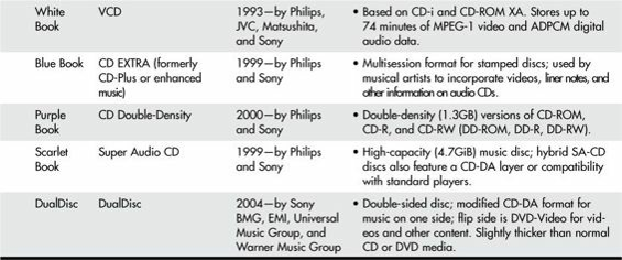Hardware Reference
In-Depth Information
Red Book—CD-DA
The Red Book introduced by Philips and Sony in 1980 is the father of all compact-disc specifications
because all other “books” or formats are based on the original CD-DA Red Book format. The Red
Book specification includes the main parameters, audio specification, disc specification, optical
stylus, modulation system, error correction system, and control and display system. The latest
revision of the Red Book is dated May 1999.
For more information on the original Red Book format, refer to the section, “
CDs: A Brief History
.”
Yellow Book—CD-ROM
The Yellow Book was published by Philips, Sony, and Microsoft in 1983 and has been revised and
amended several times since. The Yellow Book standard took the physical format of the original CD-
DA (or Red Book) standard and added another layer of error detection and correction to enable data
to be stored reliably. It also provided additional synchronization and header information to enable
sectors to be more accurately located. The Yellow Book specifies two types of sectoring—called
Mode 1 (with error correction) and Mode 2—which offer different levels of error-detection and -
correction schemes. Some data (computer files, for example) can't tolerate errors. However, other
data, such as a video image or sound, can tolerate minor errors. By using a mode with less error-
correction information, more data can be stored, but with the possibility of uncorrected errors.
In 1989, the Yellow Book was issued as an international standard by the ISO as “ISO/IEC 10149,
Data Interchange on Read-Only 120mm Optical Discs (CD-ROM).” The latest version of the Yellow
Book is dated May 1999.
Sector Modes and Forms
Mode 1 is the standard Yellow Book CD sector format with ECC and EDC to enable error-free
operation. Each Mode 1 sector is broken down as shown in
Table 11.19
.
Table 11.19. Yellow Book Mode 1 Sector Format Breakdown



